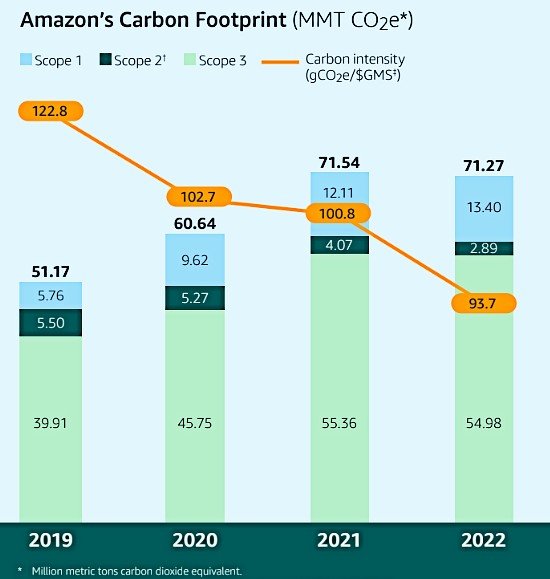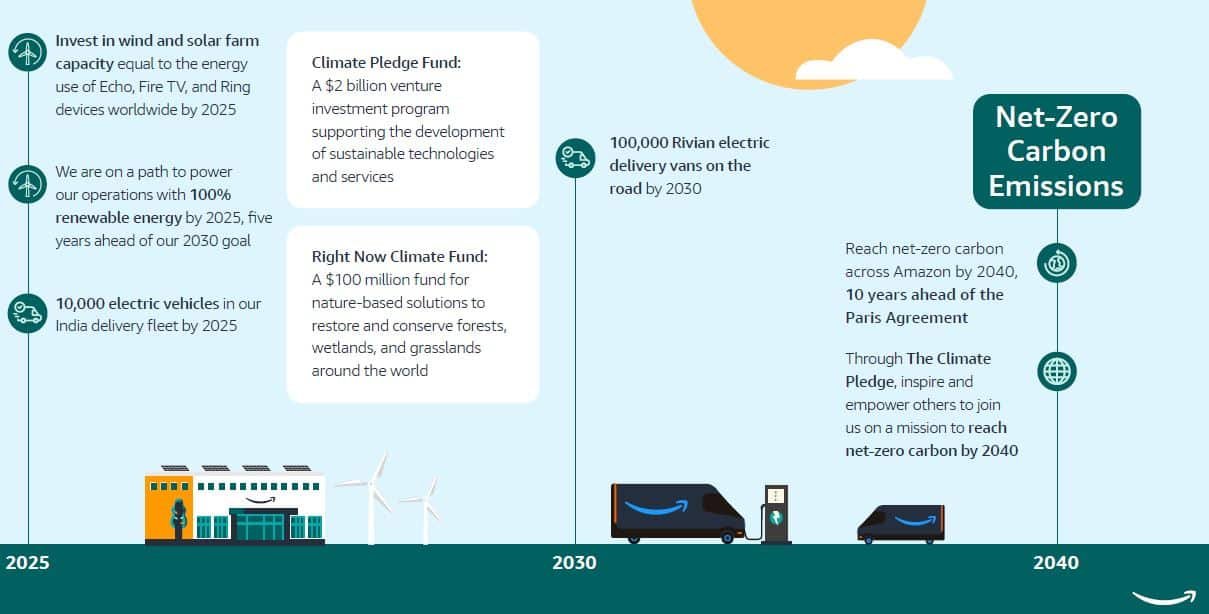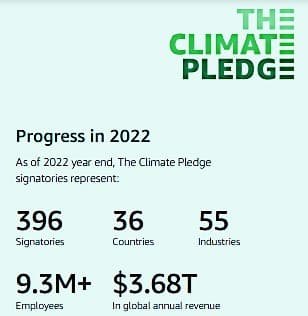Since Amazon started disclosing its carbon emissions in 2019, the retail giant saw its footprint decline for the first time as it works towards its 2040 net zero emissions goal.
The world’s largest online retailer reported in August last year that its emissions were up 40% from 2019. In the company’s latest Sustainability Report, they showed that they managed to cut emissions by 0.4% from the previous year to 71.27 million metric tons of carbon dioxide.
Amazon’s carbon intensity, emissions per dollar of sales, also dropped 7% and has decreased 24% since 2019. The retailer also reported the progress of its The Climate Pledge program, while focusing on renewable energy projects and deployment.
Working Its Way to Net Zero by 2040
After seeing increasing carbon emissions four years ago, Amazon had seen a slight decline in its footprint in 2022. The 0.4% decrease is achieved despite the company’s year-over-year net sales growing by 9%. The same goes for its carbon intensity.


Amazon said these positive climate achievements are largely due to improving efficiency across its business and growing investments in renewables.
Through Scope 1 emissions (direct operations) rise by 11%, Scope 2 emissions (purchased electricity) drop by 29%. The company focuses on decarbonizing delivery and logistics by launching the first electric heavy goods vehicles in the UK and Germany.
The company is electrifying its delivery fleet, as evidenced by buying 100,000 Rivian electric delivery vans that will hit roads in 2030. They now have over 9,000 EVs in its global fleet, and 2,600 Rivian vans in North America.
Apart from using more EVs, the e-commerce giant is also relying on green hydrogen to power its forklifts in fulfillment centers in North America.
As the largest source of its carbon footprint (77%), Amazon saw a 0.7% decrease in the value chain or Scope 3 emissions.
Nevertheless, though the company doesn’t have direct control over its Scope 3 sources, it’s working closely with suppliers to encourage them to decarbonize their own businesses, too.
Amazon is helping them by providing products and tools they need to track emissions and reduce them. Through its Supply Chain Standards, the retailer requires suppliers to share their carbon data, particularly their own carbon reduction goals.
Investing in Renewable Energy to Boost Sustainability
Shifting to renewable energy is one of the significant ways to cut emissions, according to Amazon’s Sustainability Report. Investing in renewables enables the company to achieve a 29% reduction in emissions from purchased power or Scope 2.
Early this year, the retail giant announced 401 renewable energy projects which represented over 20 GW of clean energy capacity. That’s enough to power the equivalent of 5.3 million U.S. homes each year. Part of that is the projects it signed with the Indian authorities in January, allowing it to trade renewable energy in the country.
In 2022, 90% of electricity consumed by Amazon was from renewable energy sources like solar and wind, up from 85% in 2021. The retailer further claimed in the report that they are on a path to reach 100% renewable by 2025.
Amazon has spent millions on renewable energy projects to power some of its warehouses, data centers, and offices. This makes the e-commerce leader the largest corporate buyer of renewable energy for the 3rd year in a row.
Asserting the big role of renewable energy in reaching net zero, Kara Hurst, Head of Worldwide Sustainability at Amazon said:
“We are investing in renewable energy around the world, with our teams analyzing routes and distances to build a logistics system that gets packages to customers faster, with fewer emissions.”
The key to making renewable energy more meaningful is to pair it with energy storage. In line with this, through The Climate Pledge, Amazon has invested in companies that produce green hydrogen, a type of renewable energy that can be stored for future use.
To sum up all the major points leading up to its 2040 net zero goal, Amazon has the following roadmap:


The Climate Pledge to Accelerate Sustainability Efforts
Amazon and Global Optimism co-founded the $2 billion Climate Pledge Fund in 2019. Their goal is to bring together the world’s top companies to ramp up climate actions.
It inspires other companies to make their own ambitious climate goals and strive to achieve them.
The venture investment program supports sustainable technologies and services that will help Amazon achieve net zero emissions by 2040. New investments in 2022 bring the Fund’s portfolio to 20 total companies.
Parties to the pledge agree to regularly measure and report on their carbon emissions. They then commit to reducing emissions by implementing various decarbonization measures. And any remaining footprint can be offset with permanent, real, additional, and verifiable carbon credits.
The initiative’s progress in 2022 includes 111 additional signatories and the following results:


Amazon’s 0.4% carbon reduction amid growth marks progress towards its net zero goal by 2040.
- SEO Powered Content & PR Distribution. Get Amplified Today.
- PlatoData.Network Vertical Generative Ai. Empower Yourself. Access Here.
- PlatoAiStream. Web3 Intelligence. Knowledge Amplified. Access Here.
- PlatoESG. Automotive / EVs, Carbon, CleanTech, Energy, Environment, Solar, Waste Management. Access Here.
- BlockOffsets. Modernizing Environmental Offset Ownership. Access Here.
- Source: https://carboncredits.com/amazons-carbon-emissions-take-a-green-turn-toward-2040-net-zero-with-renewable-energy/



